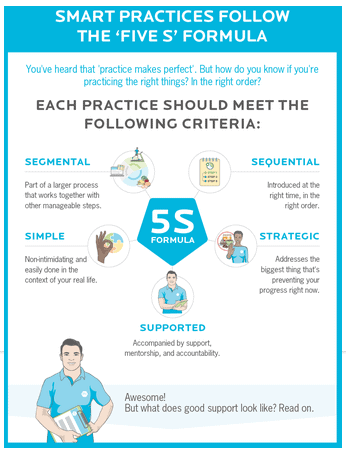Manifest Your Goals Like The Pros Do
Manifest your goals by knowing the right processes, management techniques and necessary mental/emotional alignment to succeed.
THOSE OF you who make New Years Resolutions, or are goal-makers, will soon be sitting down at your desk, on the sofa or lying on the bed musing about the year just passing, and one of three thoughts will engulf you:
- Damn, I forgot all about what those goals were (again)… did I achieve any of them?
- Or you did try; in fact you had an epic struggle to attain them, but failed, and now at year’s end this acknowledgement smacks you in the face.
- Or, happily, “you will open your Goals Workbook, flip through the many pages that recorded your progress, sign your name on the last page, put a flourishing check mark next to your signature, slowly close the cover, look out into the distance remembering the journey of accomplishment, and smile. Yes, you did it!” (source)
Which of these three experiences happens to you at the end of the New Year coming is wholly dependent on what you do right now.
If you’re interested in succeeding at a goal that has eluded you, if you want to make something new happen in your life that seems to slip through your hands year after year, I suggest you do this:
- Read the rest of this blog post to gain insights about exactly how to clear all the tripwires that have knocked you to your knees before; and
- Read the rest of this blog post to learn how to manifest your goals with proven methods and processes you can utilize now… and…
- If what you want has anything to do with everlasting, robust health, spend just one minute telling me which of my 12 ageproofing protocols you’re willing to do, and I’ll tell you how (at no cost to you).
- Why breaking down goals into small parts that become tiny habits is essential to manifest your goals.
- Why you need to be SMART and strategic on how you mange the process.
- How you can integrate the emotional and rational parts of your mind that are often at odds when it comes to goal achievement.
- What to do to get me to help you.
Last year, I wrote 4 Steps to Make Your Goals Smart and Achievable, which:
- Highlighted the four-step “SMART” system;
- Examined how the fear of commitment often stops us from even trying;
- Suggested that a back-up plan allows some zigzagging without completely ourselves off the rails; and
- Underscored the necessity of accountability.
You may read “4 Steps” later to get the details, but right now you need to know a bit of it to have context for two other systems to manifest your goals, which are:
- Precision Nutrition’s “5 S Formula”, and
- The Health Brother’s “Switch” system for integrating the rational and emotional mind.
Once you have a goal achievement system in place, the next step is to decide what you want.
If it has to do with health, tell me what that is, and as I said before, I’ll suggest what you “should” do, and – after reading all that’s here – you’ll know how to make it happen.
The 4 Steps To Make Your Goals SMART and Achievable
The “4 Steps” is pretty comprehensive, and I hope you read the article at some point. Here’s what you need to know now:
- First, get SMART by making your goals Specific, Measurable, Attainable, Relevant and Time-bound.
- Second, get rid of your Fear of Committing to a goal – it’s OK to put yourself in a position to fail.
- Third, decide in advance your IF/THEN back-up plan.
- Fourth, make yourself Accountable.
Let me point out one interesting angle on all this that I first learned from James Clear in his How To Achieve Your Goals article.
One clear way to check off the Measurable, Time-bound and Accountable attributes of the SMART system is to focus on a schedule rather than the goal itself. Of course, you first need to contemplate what the goal is, and take into consideration all that I touch on in this article, but then go to your calendar and schedule each day the little bits of what you need to do that will, over the time frame you’ve stipulated, manifest your goals.
With the 4 Steps as foundational precepts, let’s turn to Precision Nutrition’s and the Heath Brothers’ systems, and then mash them all together.
Precision Nutrition’s 5 S Formula
Precision Nutrition (PN) offers an online course about how to improve nutrition with the aim of losing weight. If you’ve ever tried to lose weight, you know that it can be hard to do, and even if successful, often times the weight comes back on.
Given the difficulty of weight loss, PN has delved into what it takes to achieve and maintain the goal of getting nice and trim, which they call the “5 S Formula”:
Simple refers to small daily actions that can be integrated into your daily life without causing resistance. Stanford University psychologist BJ Fogg calls them “Tiny Habits”, which I wrote about in How To Make Tiny Habits Big.
Segmental refers to breaking down big and/or complicated goals into defined, organized segments so that the goals are not too intimidating.
Sequential refers to practicing those segments in the right order so that success is a reliable, natural outcome.
Strategic refers to making your goal acquisition process smart enough to address whatever is in your way now, so that you will not stumble over it later.
Supported refers to someone who can help you, and to whom you are accountable, be it a friend, coach or mentor.
Here’s an illustration:
PN also offers a worksheet that looks like this (which you can get here):
PN stresses that you can reliably manifest your goals if you do two things:
- You break down each thing you want to accomplish (your goal) into specific aptitudes (skills); and
- You build those aptitudes (skills) through strategic daily actions (practices).
Therefore:
- Practice daily to build skills.
- Build skills to achieve goals.
Applying this to our favorite example, losing weight, PN suggests doing this:
- The Goal is to Lose Weight, which translates to the action of Eat Consistently Better.
- Eat Consistently Better is broken down into Skills and Practices, the skill being Hunger and Appetite Awareness, and the practices being Eating Slowly and Eating Till Satisfied, Not Stuffed (the Confucian practice of hara hachi bun me).
Is that it, you ask?
Are those the only practices you need to lose weight?
Unlikely, and PN doesn’t say that it is the only practices you need to lose weight, but that they are the first two initial practices for which there hopefully isn’t too much resistance.
Reducing resistance is important.
Remember… it’s that “tiny habits” concept.
You may refer to it as inertia, but whether inertia or resistance, the truth is that new habits are hard to establish because they inevitably require the uprooting of old habits that have burrowed into your very existence.
Next up is the Heath brothers, and then the mashup of all these goal achievement techniques.
The Heath Brothers’ Switch
I like the PN framework, but I think that one thing that’s not emphasized enough is the emotional component, something that the Heath brothers, Dan and Chip, identified and explored in their book, Switch.
As I delved into in Why Change Is Hard – The 3 Reasons We Get Stuck, it’s tough to climb out of our rut because of the lack of:
- Clarity
- Emotional Stability
- Techniques
The PN system does a fine job with #3 (“Techniques”), but before you exercise them, you need to gain some clarity and emotional stability.
The Heath brothers were quite clever in using the metaphors of the Rider, the Elephant and the Path to explain their goal acquisition system.
The Rider
The Rider is your analytical mind. It responds to clarity and common sense, and must be convinced with rationality.
For your Rider to make change happen, it must be directed to:
- Follow the bright spots (discover and clone what’s working)
- Script the critical moves (starting with small steps)
- The destination (know where you’re going and why it’s worth it)
The Elephant
The Elephant is your emotional self and it likes comfort and safety.
For your Elephant to make change happen, it must be motivated by:
- Finding the feeling (“knowing” is insufficient; it needs to “feel”)
- Shrinking the change till it’s no longer spooky
- Cultivating a “can do” identity and instilling a growth mindset
The Path
The Path must be shaped so that it makes sense to the Rider and comfortable and safe for the Elephant. That means that the Path can’t be too hard or treacherous, which circles back to our conversation about why big goals need to be broken down into “tiny habits”.
For your Path to be traveled it must be shaped:
- Tweak the environment (changing the situation changes behavior)
- Build habits (once a habit, new behavior doesn’t tax the Rider)
- Rally your buddies (behavior is contagious, so help it spread)
The Mashathon
Let’s now put this all together into one cohesive system of goal acquisition.
What we’ve reviewed so far is that:
The SMART approach requires us to carefully manage the process of achieving our goals, and understand the importance of overcoming fear and resistance, and of establishing accountability with someone else.
The Precision Nutrition approach digs into goal attainability by breaking down goals into manageable, low/no resistance (no fear) segments that are simple to do, are orderly (done in smart, strategic way) and are (again) supported by someone to whom we’re accountable.
The Heath brothers’ approach understands that we often have two minds, the emotional and rational, both of which be addressed to make the necessary lifestyle changes to accomplish a goal. Consequently, our analytical self (the Rider) must accept the purpose of the goal and the strategy to achieve it; our emotional self (the Elephant) must feel that the techniques and the goals themselves are safe and not too disrupting; and the Path we must tread to get to the goal must be properly shaped so that it supports the predilections of both the Rider and Elephant (the rational and emotional).
I guess you’ve got something to chew on.
So, ruminate on all this for a while, and soon you’ll feel well armed with the process of and psychology behind manifesting your goals.
And now, please take a few minutes to let me know what health outcomes you’d like to achieve, and I’ll develop the formulas for you.
Take The 1-Minute Survey
Last Updated on April 11, 2023 by Joe Garma








